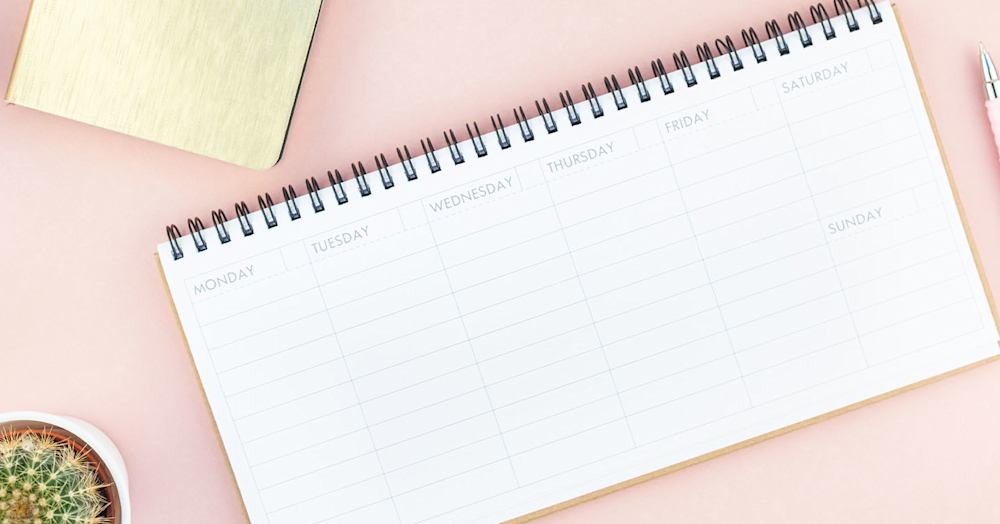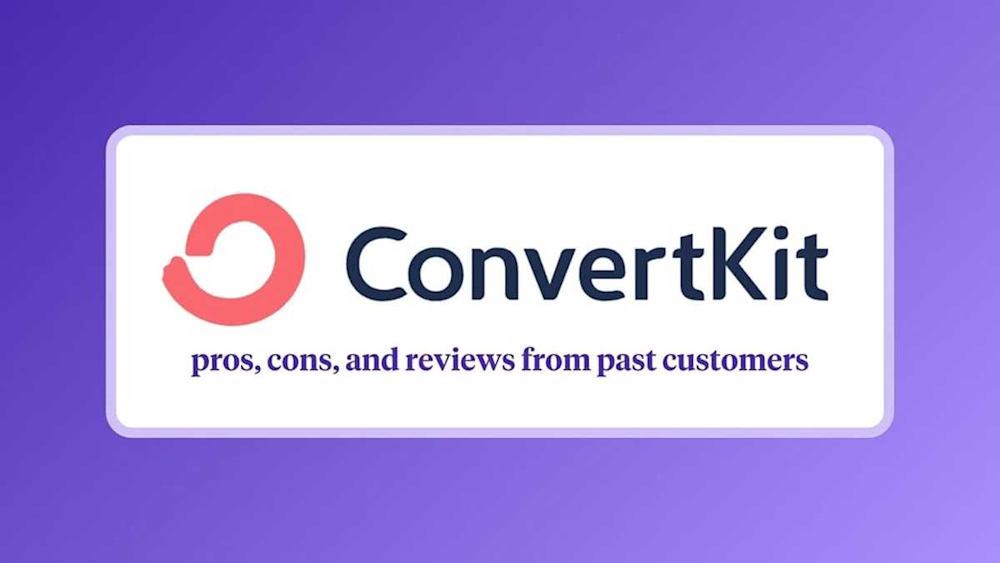You started your newsletter to connect with your audience, but now you’re wondering how to turn those opens and clicks into income. The good news?
You don’t need millions of subscribers to create a newsletter that pays you back.
You don’t even need thousands.
You just need the right people for your business and the right products that help those people solve their problems and reach their goals.
In this guide, we cover:
-
Why it’s tough to make money with a newsletter and what you can do differently
-
Five steps you can use to monetize your newsletter on autopilot
-
Examples from real creators who are using newsletters to grow, scale, and sell
Your newsletter shouldn’t just be another thing to manage. Instead, let’s make it a key part of your business that brings you new customers and profits.
Why is it so hard to make money with a newsletter?
If you’re reading this, you’ve probably put some work into starting a newsletter. (And if you haven’t started one yet, check out this post first, then come back!)
You’ve likely built up an email list — maybe it’s 20 subscribers, maybe it’s 20,000 — but monetizing it? That feels like a mystery.
You don’t want to spam people. You don’t want to sell 24/7. You started a newsletter to share your knowledge and stories, not to build the next infomercial channel.
And it’s tough because a lot of newsletter advice assumes you have a massive audience or a team behind you. Meanwhile, your newsletter takes time to write, send, and grow, and if it’s not making money, it can start to feel like a drain instead of an asset.
Everyone says your email list is your most valuable tool as a creator, but if you’re doing everything “right” and it’s still not generating income, what gives?
Is the only option to charge for access with paid newsletter subscriptions? Is it really just a numbers game? Or is there something you’re missing?
It’s easy to fall into the trap of thinking, “I need a bigger audience before this works,” or “I guess email just isn’t for me.”
But here’s the thing: creators just like you are making real income from newsletters. And they’re doing it without a mountain of subscribers, a megaphone, or a magic wand.
They’re using their email list as the engine to sell their digital products — and they’re doing it with simple systems that anyone can set up.
Building a newsletter that brings steady sales and customers
Your email newsletter isn’t just a way to stay in touch. It’s also a great sales channel.
When you sell digital products (like courses, ebooks, templates, memberships, or even a premium paid newsletter), your newsletter becomes the perfect tool for letting subscribers know what you offer, why it matters, and how they can buy.
To set this up, we need to walk through the whole process a person takes to go from stranger to subscriber to customer, and make sure we’re making the most of every revenue opportunity along the way.
1. First, we’ve got to get people on that list
Wait, I thought this post was about monetizing a newsletter, not growing one!
Yep, we’ll get there! It’s all interconnected.
Everything you do later to earn from your newsletter works so much better if new people are consistently joining your list.
That’s why step one in monetizing your newsletter is to attract the right people — the ones most likely to buy from you.
The biggest list in the world doesn’t matter if the people on it aren’t interested in what you sell, so instead of attracting everyone under the sun, start with a lead magnet. A lead magnet is a free digital product like a download, mini-course, or video training that’s related to your paid offer.
Think about the main outcome your paid product helps people achieve, then work backwards. What’s a quick win that someone could get in 10 minutes, something that helps them take the first step toward that outcome?
That’s a perfect lead magnet topic.
(You can also get even more lead magnet ideas in this article.)
Once you’ve made your lead magnet, the next step is to create a landing page for it. This page should clearly explain the benefits of signing up and make it easy to access the freebie. You should also let people know that when they sign up, they’re also joining your email newsletter.
Then, link that page everywhere (your blog posts, link-in-bio, YouTube descriptions, website header, and footer) so people can’t miss it.
For instance, Maria Ebenezer offers a free 5-day email training lead magnet that teaches subscribers how to structure their event staffing agencies. She links to this lead magnet in her website header on her “Free Resources” page so it’s easy for target customers to find.
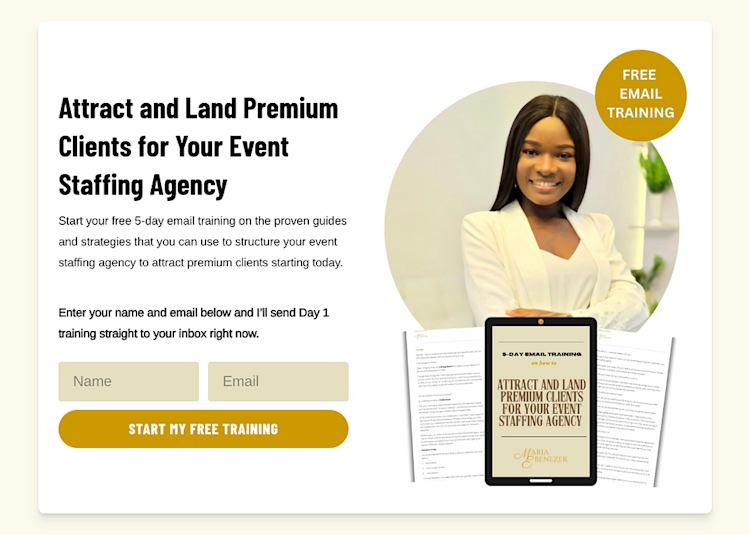
Marta in Spanish has a newsletter sign-up form right at the top of her website home page so it’s one of the first things you see. Her audience can unlock special deals on her products in exchange for signing up.

And Emily Mills from Sketch Academy shares a clear sign-up form for her free resource, “Emily’s Ultimate Guide to Sketchnoting Tools,” at the bottom of most pages on her site.
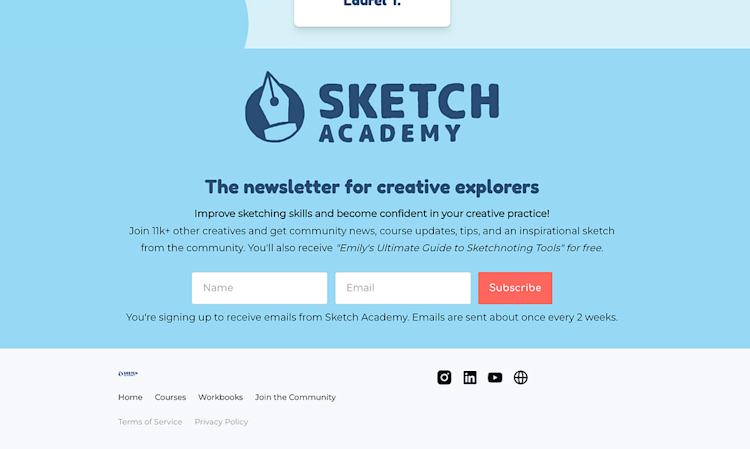
You can also make a short sales page for your newsletter itself. Tell people what they’ll get when they join, what kinds of topics you cover, and how your messages can bring value to their inbox.
And yep, add that page to your site navigation too.
2. When someone signs up, redirect them to an upsell product
Two steps in, and we still haven’t gotten to your actual email newsletter, and that’s because there’s SO much opportunity here.
Once your lead magnet is out in the world and people are signing up, you’ve got their attention. And that moment right after they subscribe? It’s a perfect opportunity to introduce a paid offer.
Before your first newsletter even hits their inbox, you can use that momentum to introduce a low-lift offer or discount, something that deepens the relationship and gives them a chance to become a customer right away.
You can do this by redirecting your lead magnet sign-up form to a thank-you page that only new subscribers see. On that page, offer an upsell that’s aligned with your lead magnet and welcoming to someone who’s just discovering your work.
Think:
-
A special coupon code
-
An exclusive product bundle
-
A mini-course, ebook, or paid webinar workshop
-
An invitation to book a free consultation
-
Or anything else that feels like a natural next step
For example, career coach Angee Linsey from Dare to Be Deliberate offers a free career vision exercise as her lead magnet. When someone signs up, they’re sent to a thank-you page with a short video where Angee walks them through the exercise. On that same page, she invites them to book a 15-minute discovery call, which naturally flows into her coaching services.
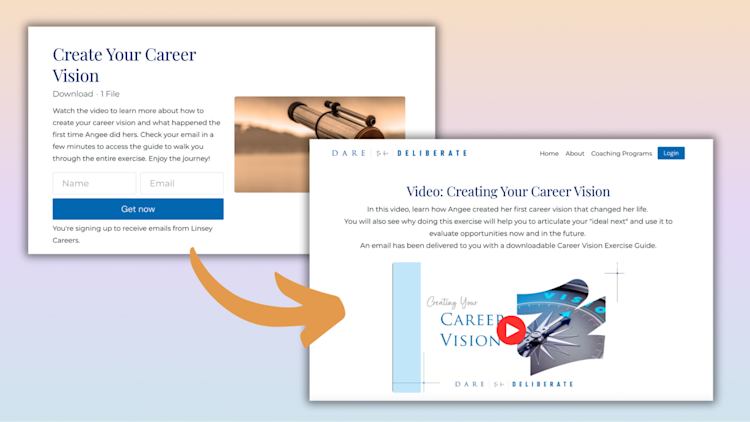
3. Automatically welcome new subscribers to your list and let them know about your paid products
Now your subscriber is on your list, but don’t wait until your next weekly or monthly newsletter to say hi.
We’re all about momentum here, so instead, let’s build a simple automated welcome sequence that shows every new subscriber who you are and what you offer.
Think of it as a mini tour of your online shop to get newsletter subscribers excited about what’s to come.
A simple three-part welcome sequence works great:
-
Day 1: Send a warm welcome and introduction to your business. Share your story, who you help, and what you’re all about.
-
Day 2: Share a helpful free resource, like a blog post, podcast episode, or YouTube video. This builds trust and delivers value right away, showing your new subscribers that you’re an expert in your field.
-
Day 3: Invite subscribers to buy one of your paid products. Tell them what outcome they can achieve and what they can find inside. This is a great place to include testimonials, case studies, sample lessons, or screenshots of discussions within your programs. And remember to add a big shiny CTA button so recipients can easily purchase.
This sequence just has three emails so you can get everything set up fast, but you can repeat emails two and three as many times as you like. There’s no such thing as too much value, and the more you help people, the more open they’ll be to hearing about your paid programs.
No high-pressure sales tactics here. You’re just making sure that everyone who joins your list knows what’s available and how to take the next step.
And best of all, subscribers will still get your regular newsletter after the sequence finishes. So even if they’re not ready to buy right away, they’ll have context for future updates and know exactly where to go when they are ready.
4. Include your products in your regular newsletter cadence
Finally, the part where we talk about your actual newsletter!
By now, you’ve built an onboarding flow that attracts potential buyers, gives them something valuable, welcomes them into your business, and tells them about your paid products. All this runs in the background, so once you set it up, you’re free to focus on your newsletter!
Your newsletter is a space where you can share stories, advice, and inspiration, all while building strong connections with your audience. But don’t forget to regularly remind your audience about the digital products you offer.
This can be as simple as including a monthly shop update (like “here’s what’s new in my business,” or “save 20% on templates this weekend”) or adding a quick product mention at the end of your regular newsletter.
One easy formula many Podia creators use is to include a CTA block at the bottom of every email featuring a product spotlight, discount, limited-time offer, or update about an upcoming product.
For example, if you’re running a cohort program and spots are filling up, mention it with a sales page link in every email you send while it’s open.
It doesn’t have to be over the top either. As Lindsay Della Vella from Midnight Medical Coding says, “I send out a weekly newsletter to everyone on my email list. There are links to the community posts in it — so people join the community each week from the newsletter.”
Again, your pitch doesn’t have to be the focus of every message, but including it regularly keeps it top of mind for readers who are on the fence.
And remember, the bulk of your newsletter should still be valuable, relevant content. Make it so helpful that people want to stick around and are naturally curious about what else you have to offer.
Here’s a sample format you can follow for your newsletters:
-
Intro: Quick update from your business or personal life
-
Helpful tip: A blog post, short lesson, or YouTube video
-
Inspiration: Something you’ve read, watched, or enjoyed lately
-
Product feature: One of your products or services that you want to highlight
This is similar to the newsletter structure used by Daniele from Swiss Innovation Academy. His emails include stories, tips, and bonuses, plus regular mentions of his ebooks and courses. He also has a dedicated landing page for his newsletter in the header of his website with links to past editions so prospects can see what to expect.
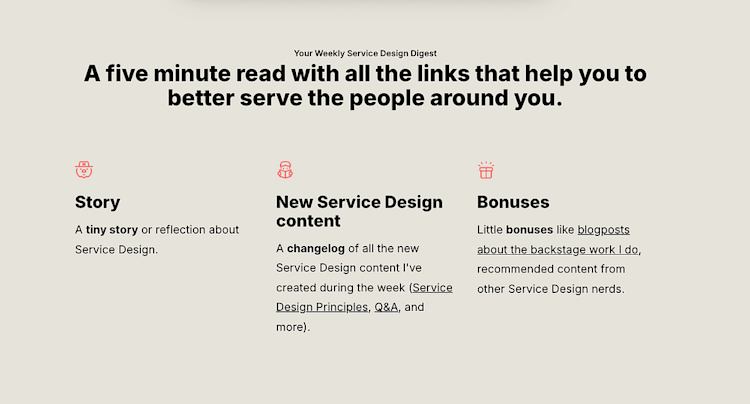
You can also mix in behind-the-scenes content as you build more products, customer stories, reviews, testimonials, and waitlist links for upcoming launches.
Sharing your waitlist helps segment your most interested subscribers so you can give them early access or share exclusive discount codes. You can also ask this group for feedback as you build to make your product even better.
Brittney Ellers, for example, had success sharing a waitlist with her email newsletter subscribers when she launched her first live course.
She says, “I did an email sequence with a waitlist and was able to sign up three women from my email list, making my first $3K through online coaching. My profession as a pelvic physical therapist has traditionally been stuck in the 1:1 brick and mortar model, and this win expanded my earning potential/capacity. It blew my mind!”
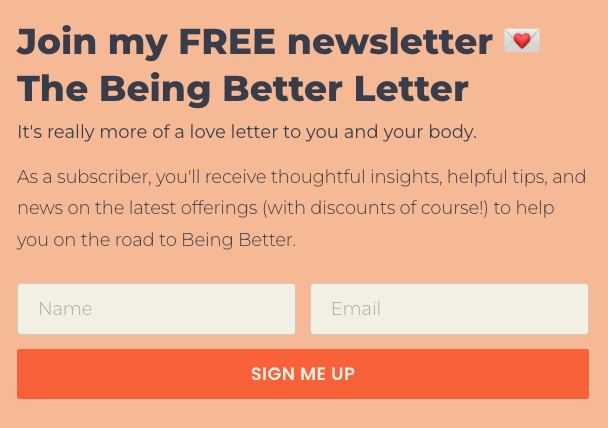
As you get into the flow of writing your newsletter, it’s important to keep your whole system in mind. Your newsletter isn’t separate from your courses and products — they’re all interconnected.
As you combine the steps of
-
growing your list with target customers and potential buyers,
-
offering an upsell that’s related to your main paid product,
-
welcoming new subscribers right when they’re most excited to hear from you, and
-
regularly sharing your product alongside your valuable newsletter content,
you create a flywheel of growth.
More content brings in more subscribers. More subscribers bring in more sales. More sales buy you the freedom to keep creating, and the cycle continues.
It’s a sustainable system — and with Podia, you can build the whole thing in one place. (Start your 30-day free trial today!)
Monetizing your newsletter isn’t always about the newsletter — it’s about the system you build around it.
When you connect your products, content, audience, and other projects with your newsletter, all the pieces of your business build on each other.
Customers who buy one product learn about other products, people who like your blog posts find out about your courses, influencers in your niche promote your projects to their audience — and it can all grow together in a way that feels natural and sustainable.
When your newsletter becomes part of a bigger business system, you go from simply sharing ideas to driving real growth.
And with Podia, you can build your newsletter, landing pages, products, and everything else you need to run a successful online business all in one place. Try Podia free for 30 days and start turning your newsletter into income.


